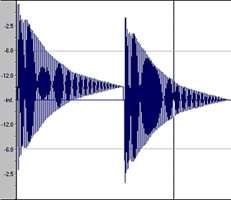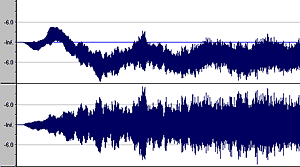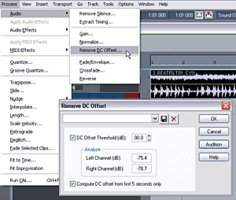
All About DC Offset
DC Offset: Case of the Missing Headroom

 Print
Print |
All About DC Offset |
 |
| By Craig Anderton on 02/08/2011 |  Print Print |
|
Like an escort service at a Las Vegas trade show, my brain went into overdrive. Pinky knew his stuff...how to gain-stage, when not to compress, how to master. If headroom was stolen right out from under his nose, it had to be someone stealthy. Someone you didn't notice unless you had your waveform Y-axis magnification up. Someone like...DC Offset.
Okay, so despite my best efforts to add a little interest, DC offset isn't a particularly sexy topic. But it can be the culprit behind problems such as lowered headroom, mastering oddities, pops and clicks, effects that don't process properly, and other gremlins.
We'll jump into the DC offset story during the 70s, when op amps became popular. These analog integrated circuits pack a tremendous amount of gain in a small, inexpensive package with (typically) two inputs and one output. Theoretically, in its quiescent state (no input signal), the ins and out are at exactly 0.00000 volts. But due to imperfections within the op amp itself, sometimes there can be several millivolts of DC present at one of the inputs.
Normally this wouldn't matter, but if the op amp is providing a gain of 1000 (60dB), a typical 5 mV input offset signal would get amplified up to 5000mV (5 volts). If the offset appeared at the inverting (out of phase) input, then the output would have a DC offset of –5.0 volts. A 5mV offset at the non-inverting input would cause a +5.0 DC offset.
There are two main reasons why this is a problem.
With capacitor-coupled analog circuits, any DC offset supposedly won't pass from one stage to the next because the capacitor that couples the two stages together can pass AC but not DC. Still, any DC offset limits dynamic range in the stage in which it occurs. (However, if the coupling capacitor is leaky or otherwise defective, some DC may make it through anyway.)
There are traditionally two ways to deal with op amp offsets.
In digital-land, there are two main ways DC offset can get into a signal.
In either case, offset appears as a signal baseline that doesn't match up with the "true" 0 volt baseline (Fig. 1).

Fig. 1: With these two drum hits, the first one has a significant amount of DC offset. The second has been corrected to get rid of DC offset, and as more headroom is available, it can now be normalized for more level if desired.

Fig. 2: The top signal is the original normalized version, while the lower one has been processed by a steep low-cut filter at 20Hz, then re-normalized. Note how the level for the lower waveform is much "hotter."

Fig. 3. Like many programs, Sonar 5's audio processing includes the option to remove DC offset from audio clips.
Digital technology has also brought about a new type of offset issue that's technically more of a subsonic problem than "genuine" DC offset, but nonetheless causes some of the same negative effects. As one example, once I transposed a sliding oscillator tone so far down it added what looked like a slowly-varying DC offset to the signal, which drastically limited the headroom (Fig. 2).
In addition to reduced headroom, there are two other major problems associated with DC offset in digitally-based systems.
There are three main ways to solve DC offset problems with software-based digital audio editing programs.
Granted, DC offset usually isn't a killer problem, like a hard disk crash. In fact, usually there's not enough to worry about. But every now and then, DC offset will rear its ugly head in a way that you do notice. And now, you know what to do about it.
Originally published on Harmony Central. Reprinted with permission.
Reproduction and distribution rights reserved © Audiofanzine 2024.
For personal use only. The user of the site acknowledges that he has read and accepts the general terms of use and that he will respect them.